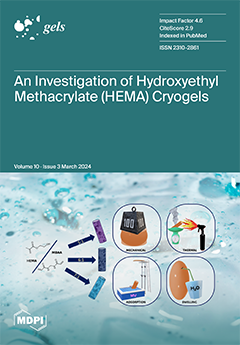In this study, cellulose/Fe
3O
4 hydrogel microbeads were prepared through the sol–gel transition of a solvent-in-oil emulsion using various cellulose-dissolving solvents and soybean oil without surfactants. Particularly, 40% tetrabutylammonium hydroxide (TBAH) and 40% tetrabutylphosphonium hydroxide (TBPH) dissolved cellulose at room temperature
[...] Read more.
In this study, cellulose/Fe
3O
4 hydrogel microbeads were prepared through the sol–gel transition of a solvent-in-oil emulsion using various cellulose-dissolving solvents and soybean oil without surfactants. Particularly, 40% tetrabutylammonium hydroxide (TBAH) and 40% tetrabutylphosphonium hydroxide (TBPH) dissolved cellulose at room temperature and effectively dispersed Fe
3O
4, forming cellulose/Fe
3O
4 microbeads with an average diameter of ~15 µm. Additionally, these solvents co-dissolved cellulose and silk, allowing for the manufacture of cellulose/silk/Fe
3O
4 hydrogel microbeads with altered surface characteristics. Owing to the negatively charged surface characteristics, the adsorption capacity of the cellulose/silk/Fe
3O
4 microbeads for the cationic dye crystal violet was >10 times higher than that of the cellulose/Fe
3O
4 microbeads. When prepared with TBAH, the initial adsorption rate of bovine serum albumin (BSA) on the cellulose/silk/Fe
3O
4 microbeads was 18.1 times higher than that on the cellulose/Fe
3O
4 microbeads. When preparing TBPH, the equilibrium adsorption capacity of the cellulose/silk/Fe
3O
4 microbeads for BSA (1.6 g/g) was 8.5 times higher than that of the cellulose/Fe
3O
4 microbeads. The pH-dependent BSA release from the cellulose/silk/Fe
3O
4 microbeads prepared with TBPH revealed 6.1-fold slower initial desorption rates and 5.2-fold lower desorption amounts at pH 2.2 than those at pH 7.4. Cytotoxicity tests on the cellulose and cellulose/silk composites regenerated with TBAH and TBPH yielded nontoxic results. Therefore, cellulose/silk/Fe
3O
4 microbeads are considered suitable pH-responsive supports for orally administered protein pharmaceuticals.
Full article






